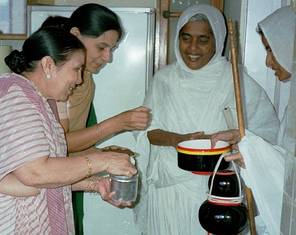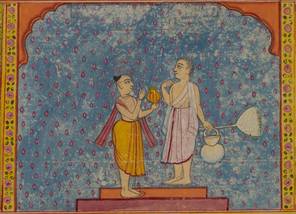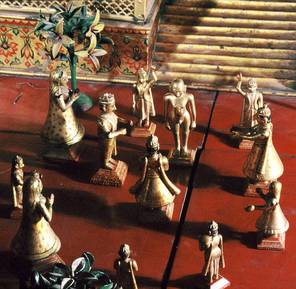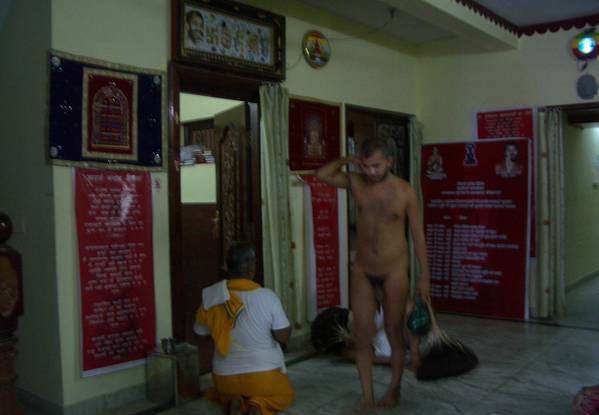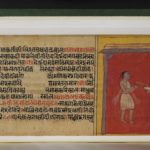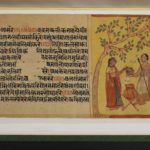Article: Giving alms
Lay people offering food or alms to mendicants is a basic aspect of the broader concept of giving – dāna – in Jain belief and the most valuable in practice. Since the Jain monks and nuns do not possess anything and have never been allowed to cook for themselves, they survive on the daily alms the Jain laity give them.
One of the common words for alms is Sanskrit bhikṣā, used in modern Indian languages as well. Another familiar word used in this context, especially in modern times, is gocarī, which literally means ‘going like a cow’. This describes the monk going for food from place to place like a cow, which eats mouthfuls of grass at different places in a field. From the point of view of the donor, offering food to mendicants is technically known as ‘the vow of sharing with a guest’ – atithi-saṃvibhāga-vrata – or ‘the gift of food’ – āhāra-dāna.
Food can be seen as central to Jain belief and identity, and the values and practices relating to food are spread through stories and scriptures. The offering and accepting of food has rules for both the lay donors and the ascetics who receive it that date back to the earliest texts and oral traditions. Mendicants may also choose to take on extra vows to enhance their spiritual progress. The giving and accepting of food alms is highly ritualised for both sides of the relationship, which are part of the fourfold community of Jains. However, there are significant differences between the rituals of the Śvetāmbara and Digambara sects, as there are in the mendicant lifestyles of each of these major sects.
Regulations on food
To a large extent, the fundamental values of Jainism can be seen in the regulations relating to food. This is especially clear in the rules for the laity’s offering of food and the mendicants’ acceptance of food offerings. Both the mendicant, who will eat the food, and the lay person, the donor, are closely involved in the process. Both have their own part to play so that the offering and acceptance conforms to doctrine.
Jain mendicants spend most of their time separated from lay people and meet them only for specific purposes. Begging for alms is a key moment in the mendicant’s daily life because it brings him or her into the outside world and into contact with others. This necessary daily contact is full of risks, which include injuring living beings, breaking the rules by offering the wrong food or in the wrong conditions.
From the earliest times, both major sects of the Śvetāmbaras and Digambaras have produced chapters or full treatises dealing with the complex set of rules that have to be obeyed by both the mendicant and the lay donor. Over the centuries these rules have at least partly changed and adjusted to fit new environments. Hence the differences between what happens today and what is set out in a large body of ancient texts are not surprising.
Rules for donors of alms
Proper alms-giving requires the potential donor to take into account certain factors. These apply to offering food but also to any other form of religious giving, such as offering a seat, lodging or clothes. Though classified and described in different ways in the scriptural tradition, they can be summed up under four main principles.
|
Principles |
Explanation |
|---|---|
|
quality of the recipient – pātra |
The best of all the recipients is the Jain mendicant, who is therefore sometimes called supātra – ‘a good recipient’. This word may also be used instead of the more common sādhu or muni. |
|
the thing given |
In the case of food, it should accord with certain rules so the mendicant can accept it. |
|
timing of the offering |
There are two parts to this rule, as follows:
|
|
quality of the donor and the manner of giving |
This is an extremely important element. The lay person who offers the alms should do it whole-heartedly, without any reluctance and with a pure and sincere mind. |
These are essential regulations, particularly the last. Narrative literature is full of characters who feel interrupted when a monk turns up on his alms round. Either they bluntly refuse to give anything or, when finally convinced to give something, they decide to get rid of something unpalatable and offer damaged or unsuitable food. There are two main outcomes. Either the mendicant eats it and dies or, realising that the food is improper after inspecting it, leaves it and survives. The bad donor always has to go through several rebirths to make up for this grave fault.
Theoretically, the donor of alms can be male or female. However, in practice both food preparation in the kitchen and the serving of food, whether to the family or to the mendicant, is mainly a woman’s role. Several Jain texts take this situation for granted, using the feminine form of words wherever they describe the rules relating to the donor.
Rules for mendicants seeking alms
Ascetics must also follow strict rules when seeking and accepting alms of food from Jain householders. These rules are long established in scriptural tradition, though there is disagreement surrounding certain points in some texts.
Rules in scriptures
There are comprehensive sections on the alms regulations in the early Śvetāmbara canonical books as well as in old Digambara treatises.
The main Śvetāmbara books are:
- the Ācārānga-sūtra, the first book – Aṅga – of the canon and representing the oldest strata of the Śvetāmbara Jain tradition, it has a special section on begging for food
- the Daśavaikālika-sūtra, which is one of the ‘fundamental’ texts – Mūla-sūtras – that Śvetāmbara mendicants learn at the beginning of their religious life, discusses the rules at length in the fifth chapter.
Among the Digambara books, the most important is chapter six of the Mūlā-cāra.
There is also a long tradition of specific treatises on searching for alms in both the Śvetāmbara and Digambara sects. They are generally extremely detailed, covering the many various situations that could arise. Here it is only possible to give a sample, highlighting the reasoning behind them.
Hunger and thirst are the first two in the list of 22 troubles – parīṣaha – that the mendicant must conquer. This is vigorously stated in the Uttarādhyayana-sūtra, which discusses rules for the mendicant life:
Though his body be weakened by hunger, a monk who is strong [in self-control] and does penance, should not cut or cause another to cut [anything to be eaten], nor cook it or cause another to cook it. Though emaciated like the joint of a crow’s [leg] and covered with a network of veins, he should know the permitted measure of food and drink, and wander about with a cheerful mind. Though overcome by thirst, he should drink no cold water, restrained by shame and aversion [to forbidden things]; he should try to get distilled water. Wandering about on deserted ways, in pain, thirsty, with dry throat, and distressed, he should bear this trouble [of thirst]
translation by Hermann Jacobi
chapter 2, stanzas 2 to 5
Everyday food

Śvetāmbara monastic bowls
Image by Nalini Balbir © Nalini Balbir
The guiding principle of the rules is that mendicants should not eat food that has been prepared specially for them. They should take small quantities from the food that the housewife has already prepared for the family for their everyday meals.
This is a form of non-violence because then the potential donors do not feel pressured into producing special food for the mendicants.
It also encourages the lay Jains to eat food that is suitable for their ascetic counterparts.
Seeking alms
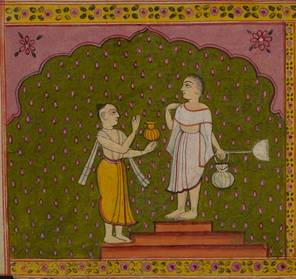
Monk receives alms
Image by British Library © CC0 1.0 (Creative Commons Public Domain)
It has always been easier to search for alms in villages or urban areas where Jain families live because they will be ready to give and at least will know of the basic rules to which the food should conform. But if Jain mendicants have to pass through areas with few Jains, this can be difficult. The possibility of being in such a situation is considered in the textual tradition, where the various obstacles that can arise on the begging tours are described at length. An example can be found on page 100 of Jacobi’s translation of the Ācārānga-sūtra.
The difficulty of getting proper alms is part of the ‘troubles’ – parīsaha – mendicants must overcome. They should neither ask for something nor complain if they do not get what they want because they should be calm at all times.
On this subject the Uttarādhyayana-sūtra states:
It will always cause difficulties to a houseless monk to get everything by begging, and nothing without begging. The hand [of the giver] is not always kindly stretched out to a monk when he is on his begging tour; but he should not think that it would be better to live as a householder. He should beg food from the householder when his dinner is ready; a wise man should not care whether he gets alms or not. ‘I get nothing to-day, perhaps I shall get something to-morrow’; a monk who thinks thus will not be grieved by his want of success
Jacobi’s translation
page 13, chapter 2, stanzas 28 to 31
Vegetarian diet
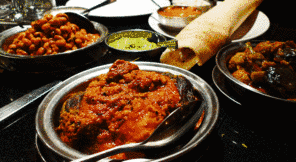
Vegetarian dishes
Image by Ewan Munro © CC BY-SA 2.0
Followers of the Jinas have been associated with strict vegetarianism from time immemorial. Even so, a few passages of the Śvetāmbara canonical scriptures show that in the distant past meat may have been eaten in extreme circumstances, as a remedy for illness for instance. These passages can be found in chapter 5 of the Daśavaikālika-sūtra or chapter 15 of the Vyākhyāprajñapti.
This possibility has given rise to many heated debates among Jains, with the medieval commentators of the texts frequently interpreting the problematic words as referring to fruit.
The notion of earlier Jains eating meat is a highly controversial matter, even among contemporary believers.
Purity of food
In order to be ‘acceptable’ or ‘pure’ according to the scriptures, the food or water which mendicants accept should not contain any living things because they have souls. This includes even the most minute or most invisible ones such as mildew, seeds or sprouts, water, dust or insects.
If a woman of the house wastes the food when distributing it, he [the monk] should refuse the giver [thus]: “I may not accept such alms”. If she crushes living beings, seeds and plants with her foot, he should avoid such a house, knowing that she performs that which is not suitable to self-control.
Daśavaikālika-sūtra
translation by Walther Schubring
chapter 5, section 1, pages 28ff
Source of food
The alms-seeker must also think about where the offered food comes from. For instance, it cannot be accepted if it has been stolen or gained through acts of violence, because non-violence is a key tenet of Jainism. Keeping this in mind, mendicants should avoid places where a festival or banquet is being held because forbidden foods may be prepared there.
Ascetics should inspect the offered food carefully. Once they are back at their lodgings, they should offer a detailed report to their teacher about how it was obtained and what it contains before eating it.
Amount of food
There are rules relating to the quantity of food that may be eaten. The theoretical amount is 32 mouthfuls, which can be interpreted differently depending on the size of a mouthful.
Availability of food
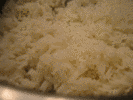
Cooked basmati rice
Image by Pearl Pirie © CC BY-NC-ND 2.0
Finally, what can be consumed also depends on what is available. This varies according to the season and the region.
Acceptable food includes the various types of Indian breads – roṭī – rice, vegetable dishes and fruit. In order to be considered pure, water must be boiled so that it does not have any minute living beings and should not be chilled.
Self-imposed restrictions
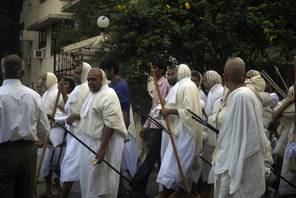
Śvetāmbara monks
Image by Hoorob – Robert Tyabji © CC BY-NC-ND 3.0
All the rules laid out in the scriptures make seeking alms difficult but the daily search can be made harder deliberately. This happens when monks and nuns set themselves extra restrictions or resolutions – abhigraha. The underlying motivation is that a greater degree of asceticism is more efficient in destroying karmas. These restrictions may be connected to the type of food and/or to specific conditions relating to the donor. The restrictions may be set for different lengths of time.
When the predetermined conditions are not fulfilled, the mendicant remains without food. Digambara mendicants commonly hold these extra resolutions and, as a result, might not eat for some time.
The story of Candanbālā illustrates an especially difficult case, where the self-imposed restrictions are such that the mendicant can effectively accept alms from only one individual.
Stories and heroes
The significance of the acts of offering and receiving alms explains why alms are a prominent theme in narrative literature. From the earliest period, stories have been a popular way to demonstrate and pass on the central values of the faith to every Jain.
Tales revolving around the most valuable aspect of dāna – offering of food to Jain mendicants – have been transmitted in various versions in all the languages Jains use. They have been both narrated separately and collected together in thematic anthologies. There is a large stock of such heroes in these stories, with the starting point of their eventful lives and rebirths an alms-giving scene.
Early examples from Śvetāmbara canonical scriptures
There are three good examples of the centrality of alms in Jain belief in the Śvetāmbara canonical scriptures.
Firstly, in the 11th book – Vivāgasuya – of the Śvetāmbara canon, there are short episodes describing alms-giving, rather than full stories. They show a fixed pattern that underlines the various stages of the process of giving. The first story tells how the householder Vijaya gives food to Mahāvīra so he can break his fast. Then the same outline is repeated with the names changed.
Prominent features of these outlines are:
- the situation
- the monk’s arrival at the lay man’s house and the welcome ritual
- the monk’s receiving the food
- the glory awaiting the donor.
The first stage involves offering food to a monk after he has observed a fast. This is considered excellent because it implies a certain solemnity, although it is more common to offer food on a daily basis to mendicants on regular begging rounds.
In the second stage, the lay man demonstrates the proper attitude and performs the ceremony of welcome when the mendicant arrives at his house for alms:
he sees the monk coming;
full of joy and happiness, he gets up from his seat,
leaves his stool,
takes off his shoes,
puts his cloth on one side of his shoulder,
goes seven or eight feet following the monk,
turns around him three times from left to right,
bows down before him, pays his respects with a large quantity of the fourfold food;
he says[,] full of happiness: “I shall give alms”; also while he is giving, he is full of happiness; also after having given, he is full of happiness.
extract from the Vivāgasuya
translation by Nalini Balbir
The third stage is expressed by a verb meaning ‘to get in return’ – the Prakrit paḍilāhei:
The monk was given the gift [of food], which was pure in three ways [mind, speech and action], and, in respect of the three modes of action [doing, causing someone to do, letting someone do], pure with regard to the substance, the donor and the taker.
extract from the Vivāgasuya
translation by Nalini Balbir
The final stage emphasises that when the monk receives the food the lay man receives merit. Therefore the link between both parties is extremely close and based on reciprocity.
This is symbolised by the list of five heavenly presents the donor can expect for his act of giving:
- a rainfall of riches
- flowers of all colours fall from the sky
- garments are tossed in celebration
- the gods‘ drums are beaten in celebration
- shouts are heard in the sky: “Wonderful! A gift! A gift!”
This list is not to be understood literally, of course. What it means is that properly offering alms to a monk is an act of merit – puṇya – that will have good results for the donor in this life and in his next births.
The second example of alms-giving in Śvetāmbara holy writings can be found in an episode starring Revatī, narrated in the fifth main book – Aṅga – the Viyāhapannatti. The recipient of her gift is the Jina Mahāvīra himself, who is suffering from an attack of fever caused by his religious opponent, Makkhali Gośāla. Revatī offers the medicine – a kind of food – that cures him and which she gives him through his disciple.
The final example demonstrates how offering improper food has negative consequences. The story of Dharmaruci is given in the sixth main book – Aṅga – of the Śvetāmbara canon. Dharmaruci is a monk who is offered food reluctantly by the lady of the house where he begs alms. She gives him a sweetened, juicy preparation of bitter melon. When the monk shows the food to his superior for inspection, as the rule prescribes, the latter realises that the food is poisonous and tries to convince Dharmaruci not to eat it. Yet he eats it in order to save the numerous ants that would otherwise be attracted to the sugared food. Dharmaruci dies.
Donors and the Jinas
Knowledge of rules concerning food offering is not thought of as having always existed. Śvetāmbaras and Digambaras both believe that proper giving – dāna – is a kind of social custom that was not widespread before it was discovered in the time of Ṛṣabhanātha or Lord Ṛṣabha, the first Jina.
Śreyāṃsa and Ṛṣabha
The origin of the rules surrounding the offering and accepting of food is conveyed through a story associated with the life of the first Jina, Ṛṣabhanātha or Lord Ṛṣabha. It is said that he wanders for a full year without food. All the people he meets offer him things he cannot accept, such as improper seating, clothes, perfumes, flowers and improper food.
Then a prince called Śreyāṃsa has various dreams or, according to other versions, remembers memories of his previous life and thus knows the characteristics of proper gifting. He offers Ṛṣabha sugarcane juice, which the Jina can accept and thus he can break his fast – pāraṇā. Therefore Śreyāṃsa is considered the first proper donor on earth.
From the tenth century onwards, this event became associated with a specific date. This date is the third day of the ‘bright fortnight’ of the month of Vaiśākha, which falls over April and May. This is known as Akṣaya-tṛtīyā – the ‘Indestructible Third’. In the 20th century, celebrating and commemorating this mythical event has become one of the main festivals of the Jain religious calendar. On this day people who have observed a year-long fast, called varṣītap, break it, in imitation of the mythical event.
Candanā and Mahāvīra
Candanā or Candanabālā is another woman associated with giving to Mahāvīra. She is an exemplary donor because she turns out to be the only one who can fulfil the very specific conditions of the resolution Mahāvīra secretly makes regarding the food he will accept.
This resolution has four points, as listed in an old version of the story.
|
Detail |
|
|---|---|
|
type of food |
This should be black beans placed in the corner of a basket |
|
the place |
The food should be offered by a person who is confined indoors and not allowed over the threshold of the door |
|
the time |
After people looking for alms would have already visited, which implies a risk of not finding any food left |
|
the donor |
The donor should be a princess reduced to slavery, with iron chains around her feet, a shaven head, and weeping, having kept a fast of three days. |
In this case also, as with Ṛṣabhanātha or Lord Ṛṣabha, Mahāvīra’s wandering is lengthy, and people are worried because he does not accept the food they offer. Such narrative features are meant to underline the merits – or in European terms the ‘luck’ – of Candanā.
Śālibhadra
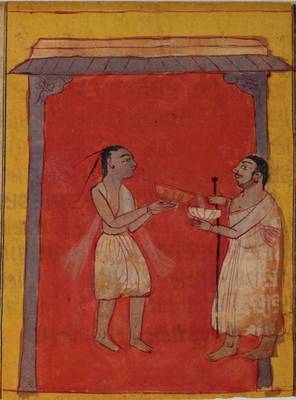
Giving milk-rice to a monk
Image by British Library © CC0 1.0 (Creative Commons Public Domain)
The story of Śālibhadra figures prominently in both the textual and the iconographic traditions. Sangama is a poor boy who is the son of a widow. One day he wants to eat milk-rice, a delicacy. His mother cannot afford to buy the ingredients, but her neighbours bring them to her. She thus prepares the milk-rice for her child. When he is about to eat, a monk happens to pass near their house. The child gives part of the dish to him, then another part, then finally the full dish.
The poor boy is reborn as Śālibhadra, the son of a rich couple, and later married to 32 maidens. After numerous events, he decides to give up worldly life and become a monk. He is encouraged to do so by Dhanya, his brother-in-law. Dhanya is married to Śālibhadra’s sister, who tells him about Śālibhadra’s wish. Dhanya also wants to make the same decision. Before they can renounce the world, both men overcome opposition from their wives and mothers.
Later on, when they have become monks, followers of Mahāvīra, he predicts that they will receive the food for their fast-breaking from the hands of Śālibhadra’s mother. When the two monks reach the gate of their former house, the doorkeeper does not recognise them and turns them away. But later, a woman selling milk feeds them curdled milk. This woman was Śālibhadra’s mother in his earlier birth as Sangama. Mahāvīra’s prediction thus comes true. Both Śālibhadra and Dhanya end their lives in the most pious way, by fasting to death.
Śvetāmbara ritual
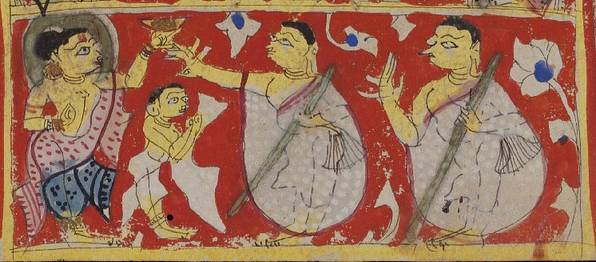
Giving alms to Śvetāmbara monks
Image by Victoria and Albert Museum © V&A Images/Victoria and Albert Museum, London
Śvetāmbara mendicants go for alms twice a day, once in the morning and once in the afternoon. This ensures that they usually eat before sunset. They receive the food in their alms-bowl – pātra.
The Āvaśyaka-cūrṇi describes the traditional Śvetāmbara ritual for donating and receiving alms.
|
1 |
When mealtime approaches, the lay person puts on his best clothes and ornaments and goes to the mendicants’ lodgings to invite them to come and accept alms. |
|
2 |
If they accept, two mendicants go with the lay man on behalf of all of them. They walk in front of him. |
|
3 |
The interaction between the mendicant and the donor is usually limited to a set of formal gestures of giving and receiving. Ideally, there should not be any words exchanged. There should be no chance for the monk or nun to ask for anything specific. |
|
4 |
The lay man directs them to his house and invites them to sit down. |
|
5 |
While entering and before leaving a household the mendicants usually say the word dharmalābha – ‘[this is an occasion for] acquiring / respecting dharma’ or karmic merit. |
|
6 |
Either the man himself gives them food and drink or he holds the platter while his wife offers the alms. |
|
7 |
He bows to the mendicants and accompanies them for a few steps as they leave. |
|
8 |
Then he may eat himself. He should eat the same food that has been offered to the mendicants because the food should not have been specially prepared for them. |
There are variants of this routine, for instance:
- there may not be an invitation to the mendicants because during their begging-tour the ascetics may come without notice to any house in the area, as shown in the Vivāgasuya
- nowadays food is not usually eaten in the donor’s house, but generally placed in the alms-bowl to be eaten at the mendicant’s lodgings.
Digambara ritual
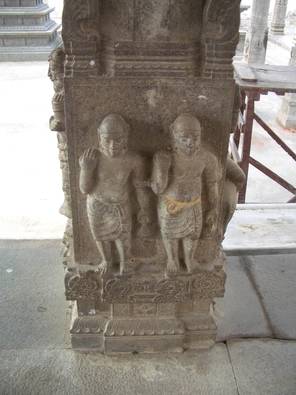
Sculpture of the Digambara alms-seeking gesture
Image by Nalini Balbir © Nalini Balbir
In contrast to the Śvetāmbaras, Digambara mendicants beg alms once a day, in the morning. They do not use any sort of receptacle or alms-bowl to receive food offered to them. Their cupped hands are the container – pāṇi-pātra.
Comparing the historical evidence of paintings and stone-carvings with contemporary practice in India, some gestures have clearly persisted down the centuries. There is a particular ritual of food-giving that is specific to the Digambara tradition and is very elaborate, though there are only a few hundred Digambara monks. With certain acts assigned to both the donor and the mendicant, the ritual unfolds in stages, each with its precise gestures. At almost every step the lay donors speak certain set phrases. Complex ceremonies surround the steps of:
- the monk signalling that he seeks alms
- potential donors inviting him to accept alms
- the lay people preparing to offer alms
- the monk taking the alms
- the end of the alms-giving.
A similar ritual takes place when food is offered to a Digambara nun – āryikā – except that she eats sitting down. Preliminary worship rituals to her are not always performed.
Monk shows he seeks alms
The monk follows a ritualised process each morning to indicate that he is looking for food.
|
1 |
The monk walks through the village or the area where he is seeking alms while holding his only two implements in his left hand: |
|
2 |
He places the tips of the five fingers of his right hand, which are pressed together, on his right shoulder. This typical gesture is called āhāra-mudrā – ‘food-gesture’. |
|
3 |
From this moment onwards, the monk will not speak until he has got and finished his meal. |
|
4 |
He also resolves not to take any food after eating that day till the next day. |
Potential lay donors
Lay people who wish to offer alms to the monk must follow a sequence of ceremonial steps and utter ritual phrases. If they do not complete the rite properly, the monk will not accept alms from them. They will thus not gain any merit from giving alms that can aid their karma.
|
1 |
To ensure they are pure enough to offer alms to a monk, the potential donors must first perform the morning religious duties and dress in ritually pure clothing, untouched by others. |
|
2 |
Then they wait for the monk, holding a pot of pure water, topped with a washed coconut, a rosary or some other auspicious object. |
|
3 |
When they see the monk, they greet him with an invitation formula in Sanskrit or in a mixture of Sanskrit and the local language. The invitation phrase says: “Honour to you, honour to you! Stand still, stand still! The food and water are pure.” |
|
4 |
If the monk stops before these people, it means he is considering accepting their offer. Then they move clockwise around the monk thrice, keeping him on their right – pradakṣiṇā – side and saying, “Respects!” each time. |
|
5 |
Then the lay people tell him that they are pure in mind, body and speech, and that the food they will offer is pure as well. |
Preparing to eat
It is very important that lay people from whom a monk chooses to accept alms perform the necessary ceremonies properly. These involve ritual purifications, demonstrating respect and creating auspicious symbols. There are several stages they must follow to make sure that everything is ready for the monk to accept their alms.
|
1 |
The lay donors ritually purify the ground leading to the house by sprinkling water on it. |
|
2 |
Before the monk enters the house, they sprinkle water on his feet to wash off any dust. |
|
3 |
The monk carries only the peacock broom inside, leaving the water pot at the entrance. |
|
4 |
Once in the house, he is offered a low stool or a raised platform on which he will stand. This is a way to show him respect. |
|
5 |
The lay people wash the feet of the monk, using a bowl of water. When they have finished, they dip their fingers into the bowl and sprinkle some of this water on their heads, to show their respect. |
|
6 |
They perform three short rituals in front of the monk. They use sandalwood paste or rice grains to draw auspicious symbols, such as the svastika. |
|
7 |
They perform and utter another respectful formula in front of the monk. |
|
8 |
They again assure him that the food they offer him will be pure. |
|
9 |
Finally they ask the monk to show them his hands, as a sign that he is ready to accept food from them. |
|
10 |
The monk stands on the low stool ready to eat. |
Accepting the offering
When the monk has signalled that is he is ready to receive the alms the lay people offer, the ritual of giving and accepting food begins.
|
1 |
The monk holds his hands above a bowl on the floor. |
|
2 |
The lay people pour some water on his hands and offer him some rice flour so he can wash his hands. |
|
3 |
He then interlaces all his fingers except the thumbs. It is crucial that the hands are not separated at all during the eating process. If this happens, it is an obstacle that puts an end to the offering and eating of food. |
|
4 |
When the food is poured into his hands, the monk uses his thumbs to sift through it so he can inspect it and see that it contains no hair, insect or similar. If he finds anything like that, it ends the whole process. Once he is satisfied that the food is acceptable, he can eat it. |
|
5 |
When the mendicant has finished the handful of food, he interlaces his joined hands for the donors to put more food in them. He indicates that he has had enough by folding his hands. |
After the offering of food
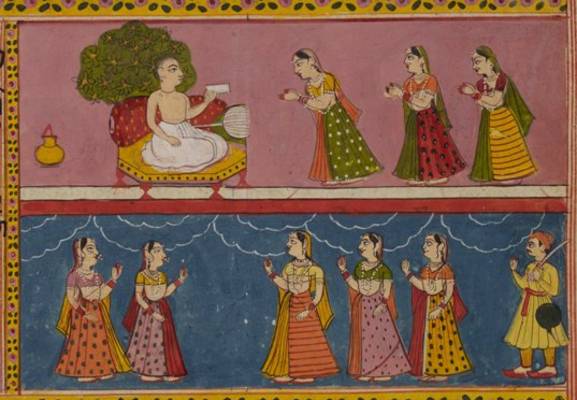
Ladies pay their respects to a monk
Image by British Library © CC0 1.0 (Creative Commons Public Domain)
When the alms have been given and received, there is a further rite to perform before the ceremony of alms-giving is considered to have ended. This mainly involves the lay people who have donated alms.
|
1 |
When the monk has finished eating, he sits down on the low stool. |
|
2 |
The lay people give him water to wash his hands and rinse his mouth. |
|
3 |
If any food has fallen on his body, they wipe it off with a moist piece of cloth. |
|
4 |
When the monk stands up to go, the donors accompany him to his lodgings and hand him the peacock-feather broom and water pot. |
|
5 |
The food that has been left is distributed among those present as a back-offering – prasāda. |
The monk has remained silent from the moment he makes the ritual gesture of seeking alms, known as āhāra-mudrā – ‘food-gesture’. After the alms-giving ceremony has finished, he may talk once again.
When he leaves the donors, the monk goes back to his teacher or to the group to which he belongs and gives a report on the food he has been offered, giving details about the laity’s behaviour and so on.
Reading
- ‘The Micro-Genre of Dāna-Stories in Jaina Literature: Problems of Interrelation and Diffusion’
Nalini Balbir - Indologica Taurinensia
edited by Nalini Balbir and Colette Caillat
volume 11
International Association of Sanskrit Studies; 1983
- The Jains
Paul Dundas - Library of Religious Beliefs and Practices series; series editor John Hinnels and Ninian Smart; volume 14
Routledge Curzon Press; London, UK; 2002
- Riches and Renunciation: Religion, Economy and Society among the Jains
James Laidlaw - Oxford Studies in Social and Cultural Anthropology series
Oxford University Press; Oxford, UK; 1995
- ‘Le don de nourriture aux ascètes jaïns digambar: dynamique sociale et évolution’
Marie-Claude Mahias - Rites hindous: Transferts et transformations
edited by G. Colas and G. Tarabout
Puruṣārtha series; volume 25
École des hautes études en sciences sociales; Paris, France; 2006
- Historical Dictionary of Jainism
Kristi L. Wiley - Historical Dictionaries of Religions, Philosophies, and Movements series; series editor Jon Woronoff; volume 53
Scarecrow Press; Maryland, USA; 2004
- Jaina Yoga: A Survey of the Mediaeval Śrāvakācāras
Robert Williams - London Oriental series; volume XIV
Oxford University Press; London, UK; 1963
- ‘The Ritual Giving of Food to a Digambara Renunciant’
Robert J. Zydenbos - Approaches to Jaina Studies: Philosophy, Logic, Rituals and Symbols
edited by N. K. Wagle and Olle Qvarnström
volume 11
Centre for South Asian Studies, University of Toronto Press; Toronto, Canada; 1999
Links
- Digambara monk takes alms from lay women
-
This video on YouTube shows a Digambara monk eating alms offered by lay women. The women gather round and put spoonfuls of food into his cupped hands. He moves his thumbs quickly through it to ensure it is pure enough to eat.
- Re-enactment of the story of Candanabālā
-
This slideshow displays the re-enactment of the story of Candanabālā, who offered Mahāvīra appropriate food to break his fast. Sold into slavery, the beautiful princess has her lovely hair chopped off and is starved for three days. Even so, her first act when released is to offer alms to a passing mendicant. He is Mahāvīra, who becomes the 24th Jina, and he has been fasting for nearly six months. Candanabālā’s act of selfless charity despite her suffering causes her hair to be restored and her true identity revealed. The story of this virtuous woman – one of the soḷa satī – emphasises the importance of offering alms correctly. Acting out such stories is an important part of many Jain festivals. This re-enactment on YouTube was performed by Śvetāmbara Jains in Melbourne, Australia during the festival of Paryuṣaṇ in 2010.
- Five Great Monastic Vows
-
Pravin K. Shah writes about the Five Great Vows taken by Jain monks and nuns. The information is provided by the Jainism Literature Center, associated with the Faculty of Arts and Sciences at Harvard University.
http://www.fas.harvard.edu/~pluralsm/affiliates/jainism/jainedu/5greatvows.htm
- +
- aAbhavya
- aAbhinandana
- aAbhiṣeka
- aĀcāra
- aĀcārāṅga-sūtra
- aĀcārya
- aAchalbhrata
- aAḍhāī-dvīpa
- aAdharma
- aAdho-loka
- aAdhyayana
- aAdvaita Vedānta
- aĀgama
- aAghātīya
- aAghātīya-karman
- aAgnibhuti
- aAgra
- aĀhāra
- aAhiṃsā
- aAhimsa Day
- aAjita
- aAjīva
- aAkampit
- aĀkāśa
- aAkbar the Great
- aAkṣaya-tṛtīyā
- aAlauddin Khalji
- aAlbert Einstein
- aAllah
- aAlms
- aĀlocanā
- aAloka-ākāśa
- aAmāri
- aAmbikā or Kūṣmāṇḍinī
- aAnagāra
- aAnanta
- aAnarthadaṇḍa
- aAnaśana
- aAnekānta-vāda
- aAṅga
- aAniconism
- aAnojjā
- aAntarāla
- aAntarāya-karma
- aAṇu
- aAṇu-vrata
- aAnukampā
- aAnuprekṣā
- aAnusvāra
- aApabhraṃśa
- aAparigraha
- aAra
- aĀrambha
- aĀrambhaja
- aĀratī
- aArdhamāgadhī Prākrit
- aArhaṃ
- aArhat
- aArśana-āvaraṇīya-karma
- aĀrta-dhyāna
- aĀryikā
- aĀryikā Jñānamati
- aĀśātanā
- aĀścarya
- aAscetic
- aAsceticism
- aAshram
- aAspiration
- aĀsrava
- aAṣṭa-maṅgala
- aAṣṭāpada
- aAstikāya
- aAstrolabe
- aAsura
- aAtheism
- aAticāra
- aAtiśayakṣetra
- aAtithisaṃvibhāgavrata
- aĀtma-vāda
- aĀtman
- aAuṃ
- aAurangzeb
- aAuspicious
- aAusterity
- aAvadhāna
- aAvadhi-jñāna
- aĀvaraṇī-yakarman
- aAvasarpiṇī
- aAvatāra
- aAvidyā
- aAxiom
- aĀyāga-paṭa
- aĀyambil
- aĀyu-karma
- aĀyurveda
- bBabur
- bBāhubali
- bBaladeva
- bBālāvabodha
- bBandha
- bBasadi
- bBazaar
- bBhadrankarvijay
- bBhagavant
- bBhaktāmara-stotra
- bBhakti
- bBhale
- bBharata
- bBhāṣā
- bBhāṣya
- bBhaṭṭāraka
- bBhāva
- bBhāva-pūjā
- bBhāvanā
- bBhavana-vāsin
- bBhavya
- bBhavyatva
- bBhaya
- bBhoga-bhūmi
- bBhogopabhoga
- bBodhi
- bBollywood
- bBrahmā
- bBrahma-deva
- bBrahmacārī
- bBrāhmaṇa
- bBraj Bhāṣā
- bBright fortnight
- bBritish Raj
- bBuddha
- bBuddhi-sagar
- bBuddhism
- bBuddhist
- cCaitya
- cCaityavāsin
- cCakravartin
- cCakreśvarī
- cCāmara
- cCandanā
- cCandragupta
- cCandraprabha
- cCanon
- cCāritra
- cCāritramohanīya-karman
- cCarũrī
- cCaste
- cCaturvidha-saṅgha
- cCaturviṃśati-stava
- cCāturyāma
- cCE
- cCelibacy
- cCha
- cChadmastha
- cChastity
- cCheda-sūtra
- cChristian
- cChristianity
- cClergy
- cCloning
- cColophon
- cCommentary
- cConch
- cConfession
- cCongregation
- cConsecration
- cCosmology
- cCremation
- cCrore
- cCult
- cCūrṇi
- dDādā-guru
- dDalit
- dDāna
- dDaṇḍa
- dDark fortnight
- dDarśana
- dDarśanamohanī-yakarman
- dDaśa-lakṣaṇa-parvan
- dDeity
- dDelhi Sultanate
- dDerāsar
- dDeśāvakāśika-vrata
- dDetachment
- dDevanāgarī
- dDevānandā
- dDevarddhi-gani
- dDevotee
- dDhamal
- dDhanuṣ
- dDhāra
- dDharma
- dDharma-dhyāna
- dDharma-sāgara
- dDharmastikaya
- dDhātakīkhaṇḍa
- dDholak
- dDhyāna
- dDiaspora
- dDig-vrata
- dDigambara
- dDīkṣā
- dDisciple
- dDīvālī
- dDivya-dhvani
- dDNA
- dDoctrine
- dDogma
- dDonor
- dDoṣa
- dDravya
- dDravya-pūjā
- dDrone
- dDuṣamā
- dDuṣamā-duṣamā
- dDuṣamā-suṣamā
- dDveṣa
- dDvīpa
- eEast India Company
- eEightfold Path
- eEkānta-vāda
- eEkendriya
- eElder
- eElders
- eEschatology
- eEtc up to
- fFarmān
- fFast
- fFatehpur Sikri
- fFestival
- fFestschrift
- fFiruz Shah
- fFly-Whisks
- fFolio
- fFour Noble Truths
- gGaccha
- gGaṇa
- gGaṇadhara
- gGanadharavada
- gGaṇeśa
- gGaṇin
- gGarba
- gGarbha
- gGarbha-gṛha
- gGaruḍa
- gGati
- gGene
- gGenomics
- gGhātī-yakarman
- gGhātīya
- gGhaznavid
- gGhiyasuddin Tughlaq
- gGhurid
- gGloss
- gGotra-karma
- gGujarāt
- gGujarati
- gGuṇa
- gGuṇa-sthāna
- gGuṇa-vrata
- gGupti
- gGuru
- gGuruṇī
- hHagiography
- hHajj
- hHaṃsa
- hHaribhadra
- hHariṇaigameṣin
- hHasta
- hHeresy
- hHiṃsā
- hHindi
- hHindu
- hHinduism
- hHīravijaya
- hHoroscope
- hHrīṃ
- hHumayun
- hHymn
- iIconoclasm
- iIconography
- iIdol
- iIndian Independence
- iIndology
- iIndra
- iIndrabhūti Gautama
- iIndriya
- iInitiation
- iIntercession
- iInvocation
- iIQ
- iIslam
- iIslamicate
- iIṣṭadevatā
- iĪśvara
- jJagat
- jJahangir
- jJain
- jJaina Devanāgarī
- jJaina Śaurasenī
- jJaina-dharma
- jJainaśāsana
- jJainness
- jJaisalmer
- jJamāli
- jJambū-dvīpa
- jJames Burgess
- jJanma
- jJanma-kalyāṇa
- jJarā
- jJāti
- jJina
- jJina-āgama
- jJina-bhavana
- jJina-bimba
- jJina-mātā
- jJinacandra-sūri
- jJinadatta
- jJinaprabha
- jJīva
- jJñāna
- jJñāna-āvaraṇīya-karma
- jJñāna-āvarṇiya
- jJñānsundar
- jJyotiṣka
- kKāla
- kKālakācārya-kathā
- kKālidāsa
- kKalpa-sūtra
- kKalpa-vṛkṣa
- kKalyāṇaka
- kKalyanvijay
- kKamaṇḍalu
- kKamaṭha
- kKarma
- kKarma-bhūmi
- kKarma-grantha
- kKarma-prakṛti
- kKarma-vāda
- kKarmon
- kKarnataka
- kKaṣāya
- kKathā
- kKāvya
- kKāya
- kKāyotsarga
- kKeśa-loca
- kKetu
- kKevala-jñāna
- kKevalin
- kKhalji
- kKharatara-gaccha
- kKnowledge
- kKriyā
- kKriyā-vāda
- kKṛṣṇa
- kKṣamā-śramaṇa
- kKṣapakaśreṇi
- kKṣatriya
- kKṣullaka
- kKulakara
- kKundakunda
- kKunthu
- lLabdhi
- lLaity
- lLakh
- lLāñchana
- lLands of Action
- lLaukāntika
- lLavaṇa-samudra
- lLeśyā
- lLiṅga
- lLinguistics
- lLoka
- lLoka-ākāśa
- lLoka-puruṣa
- lLoka-vāda
- lLotus
- lLotus lake
- mMadhya-loka
- mMahā-videha
- mMahā-vrata
- mMahābhārata
- mMahāmastakābhiṣeka
- mMāhārāṣṭra
- mMāhārāṣṭrī Prākrit
- mMahattarā Yākinī
- mMahāvīr Jayantī
- mMahāvīra
- mMakāra
- mMakkhali Gośāla
- mMalli
- mMāna-stambha
- mManaḥ-paryāya-jñāna
- mMaṇḍala
- mMaṇḍapa
- mMandit
- mMaṅgala
- mMantra
- mMantras
- mManuṣya-loka
- mMarāṭhī
- mMārgaṇā
- mMartyr
- mMarudevī
- mMaṭha
- mMati-jñāna
- mMauryaputra
- mMecca
- mMendicant lineage
- mMetarya
- mMiracle
- mMithyādṛṣṭi
- mMohandas Gandhi
- mMohanīya-karma
- mMokṣa
- mMonastic order
- mMonasticism
- mMonk
- mMonotheism
- mMosque
- mMount Meru
- mMount Sammeta
- mMṛgāvatī
- mMughal
- mMuhammad
- mMuhammad bin Tughlaq
- mMuhpattī
- mMūla-sūtra
- mMūlaguṇa
- mMumbaī
- mMuni
- mMunisuvrata
- mMurad Bakhsh
- mMūrti-pūjaka
- mMuslim
- mMysticism
- nNābhi
- nNāga-kal
- nNāgapurīya Tapā-gaccha
- nNāgarī
- nNāma-karma
- nNamaskāra-mantra
- nNami
- nNandīśvara-dvīpa
- nNandivardhana
- nNandyāvarta
- nNāraka
- nNāraki
- nNasalisation
- nNātha
- nNavrātrī
- nNaya-vāda
- nNemi
- nNidāna
- nniggaṃthāṇa vā 2
- nniggaṃtho vā 2
- nNigoda
- nNihnava
- nNikṣepa
- nNirgrantha
- nNirjarā
- nNirvāṇa
- nNiryukti
- nNiṣidhi
- nNitya
- nNiyati
- nNo-kaṣāya
- nNudity
- nNun
- oOcean of milk
- oOmniscience
- oOrdination
- ppa°
- pPadmaprabha
- pPadmāsana
- pPadmāvatī
- pPādukā
- pPalanquin
- pPalette
- pPañca-muṣṭi
- pPāṇḍava
- pPaṇḍit
- pPandit Dalsukh D. Malvania
- pPandit Sukhlalji
- pPāṇipātra
- pPāpa
- pParamātman
- pParameṣṭhin
- pPāraṇā
- pParigraha
- pPariṇāma
- pParīṣaha
- pParokṣa
- pPārśva
- pPārśvanātha
- pParyāya
- pParyuṣaṇ
- pPaṭa
- pPatan
- pPātra
- pPenance
- pPersian
- pPhala
- pPhilology
- pPicchikā
- pPilgrimage
- pPīr
- pPolymath
- pPoṣadha
- pPossession
- pPothī
- pPrabhas
- pPradakṣiṇā
- pPradeśa
- pPrākāra
- pPrakīrṇaka-sūtra
- pPrākrit
- pPramāda
- pPramukhā
- pPrati-vāsudeva
- pPratikramaṇa
- pPratimā
- pPratiṣṭhā
- pPratyākhyāna
- pPratyakṣa
- pPravacana
- pPrāyaścitta
- pPrayer
- pPre-modern
- pPreach
- pPredestination
- pProtestant
- pProvenance
- pPudgala
- pPūjā
- pPujārī
- pPukharavara-dvīpa
- pPuṇya
- pPūrva
- pPuṣkara-dvīpa
- pPuṣpadanta
- pPyre
- qQur’an
- rRāga
- rRāhu
- rRainy season
- rRajasthan
- rRajasthani
- rRājimatī
- rRajoharaṇa
- rRajput
- rRāma
- rRāmāyaṇa
- rRangoli
- rRās-garbā
- rRasa
- rRathanemi
- rRatna-traya
- rRātri-bhojana
- rRaudra-dhyāna
- rRecto
- rRelic
- rRenunciation
- rRetroflex
- rRevatī
- %Ṛg-veda
- rRite
- rRosary
- %Ṛṣabha
- %Ṛṣabhanātha
- rRupee
- sSaciyā Mātā
- sSādhu
- sSādhvī
- sSāgāra
- sSaint
- sŚaivaism
- sŚaka-saṃvat
- sSallekhanā
- sŚalya
- sSamacatuṣṭha
- sSamādhimaraṇa
- sSamaṇi
- sSāmarambha
- sSamavasaraṇa
- sSāmāyika
- sSaṃbhava
- sSamiti
- sSaṃjñā
- sSaṃkalpaja
- sSaṃsāra
- sSamudghāta
- sSaṃvara
- sSaṃvega
- sSamyak-cāritra
- sSamyak-darśana
- sSamyak-jñāna
- sSamyaktva
- sSaṃyama
- sSanctuary
- sSandalwood
- sSaṇgha
- sSanskrit
- sSant
- sŚānti
- sSapta-bhaṅgi-naya
- sSārambha
- sSarasvatī
- sSarvajña
- sSāsan-devi
- sŚāsana-devatā
- sŚāstra
- %Ṣaṭ-jīvanikāya
- sSatī
- sSatīmātā
- sSatya
- sSchism
- sScribe
- sScripture
- sSect
- sSecularism
- sŚenāī
- sSermon
- sŚeṣavatī
- sSevā
- sSeven fields of donation
- sShah Jahan
- sShantidas Jhaveri
- sShrine
- sSiddha
- sSiddha-śilā
- sSiddhacakra or Navadevatā
- sSiddhānta
- sSiddhārtha
- sSiddhi
- sSikh
- sSikhism
- sŚikṣā-vrata
- sŚīla
- sSin
- sSindh
- sŚītala
- sŚiva
- sSkandha
- sSomanatha
- sŚraddhā
- sŚramaṇa
- sŚrāvaka
- sŚrāvakācāra
- sŚrāvikā
- sŚreyāṃsa
- sŚrī
- sŚrīvatsa
- sŚruta-jñāna
- sŚruta-pañcamī
- sSthānaka-vāsin
- sSthāpanācārya
- sSthāvara
- sSthavira
- sSthiti
- sStrīmukti
- sStūpa
- sSubcontinent
- sSudarshana
- sŚuddhi
- sSudharma
- sŚūdra
- sSufism
- sSukha
- sŚukla-dhyāna
- sSulasā
- sSultan
- sSumati
- sSundarśrī
- sSupārśva
- sSūri
- sSuṣamā
- sSuṣamā-duṣamā
- sSuṣamā-suṣamā
- sSūtra
- sSuyam me ausam! Tenam bhagavaya evamakkhayam
- sSvādhyāya
- sSvāhā
- sSvastika
- sŚvetāmbara
- sŚvetāmbara Terāpanthin
- sŚvetāmbaras
- sSwan
- sSyād-vāda
- tTabla
- tTantra
- tTapā-gaccha
- tTapas
- tTāraṇ Svāmī Panth
- tTattva
- tTattvārtha-sūtra
- tTemple
- tTemple-city
- tThe Enlightenment
- tTheology
- tThree worlds
- %Ṭīkā
- tTilaka
- tTīrtha
- tTīrthaṃkaranāma-karman
- tTīrthankara
- tTransliteration
- tTrasa
- tTrasa-nāḍī
- tTriśalā
- tTriṣaṣṭi-śalākā-puruṣa-caritra
- tTti bemi
- tTughlaq
- tTunk
- uUdumbara
- uUniversal History
- uUpādhyāya
- uUpāṅga
- uUpaniṣads
- uUpāsaka
- uUpasarga
- uUpāśraya
- uŪrdhva-loka
- uUtsarpiṇī
- uUttarādhyayana-sūtra
- vVāhana
- vVaimānika
- vVairāgya
- vVaiṣṇava
- vVaiśramaṇa
- vVaiśya
- vValabhī
- vVanaspatikāya
- vVandana
- vVaṇik
- vVarṇa
- vVāsudeva
- vVāsupūjya
- vVayubhūti
- vVeda
- vVedanīya-karma
- vVegetarianism
- vVehicle
- vVernacular
- vVerso
- vVidyā
- vVidyā-devī
- vVihāra
- vVijñapti-patra
- vVikrama-saṃvat
- vVikṛti
- vVimala
- vVinaya
- vVipāka
- vVirji Vora
- vVirodhaja
- vVīrya
- vVisarga
- vViṣṇu
- vVītarāga
- vVizier
- vVotive
- vVow
- vVrata
- vVS
- vVyakta
- vVyantara
- vVyasana
- yYakṣa
- yYakṣī
- yYantra
- yYaśoda
- yYaśovijaya
- yYati
- yYātrā
- yYoga
- yYoginī
- yYojana


